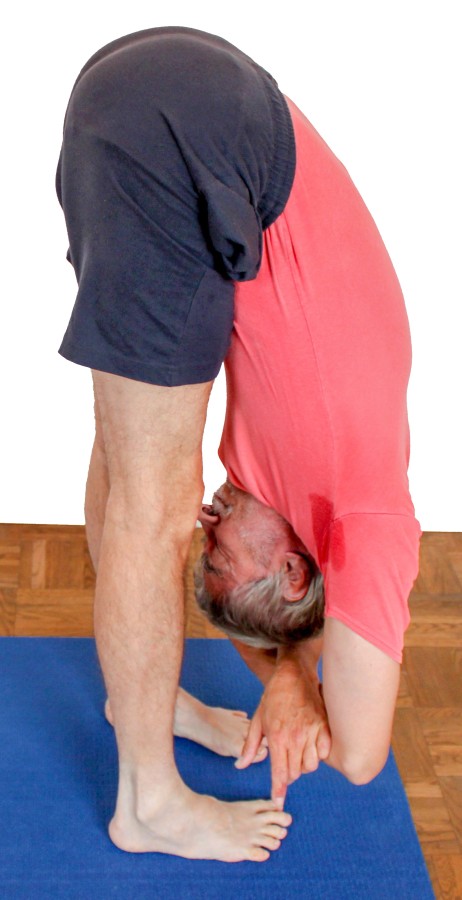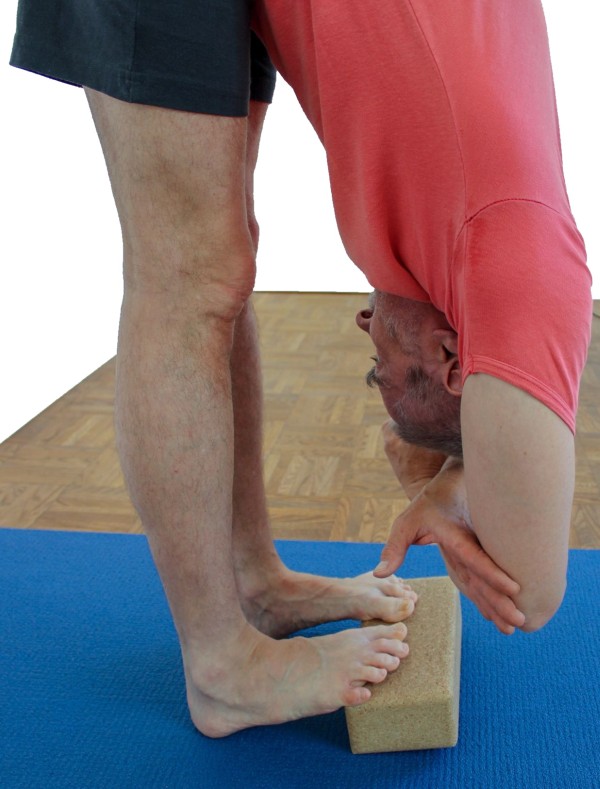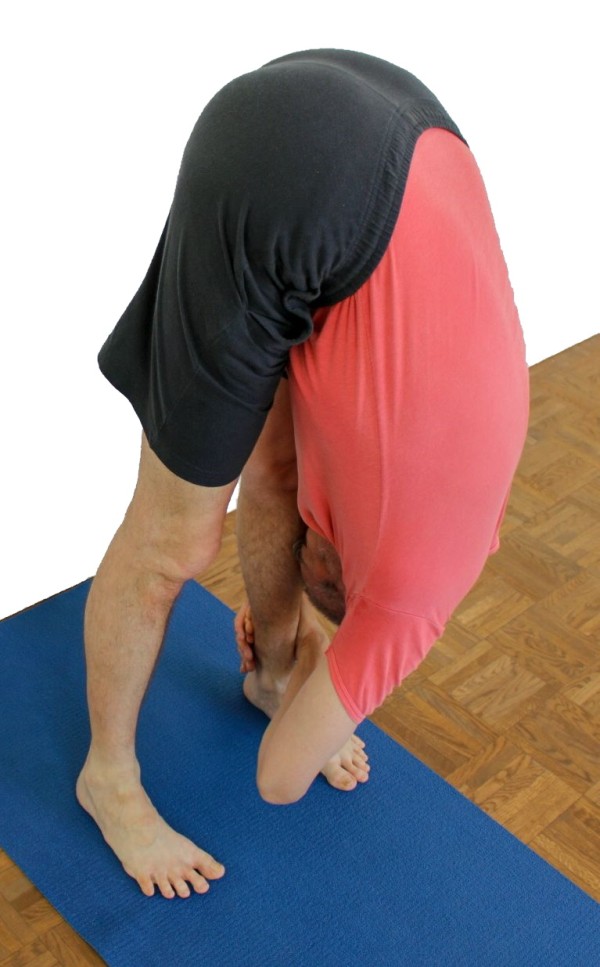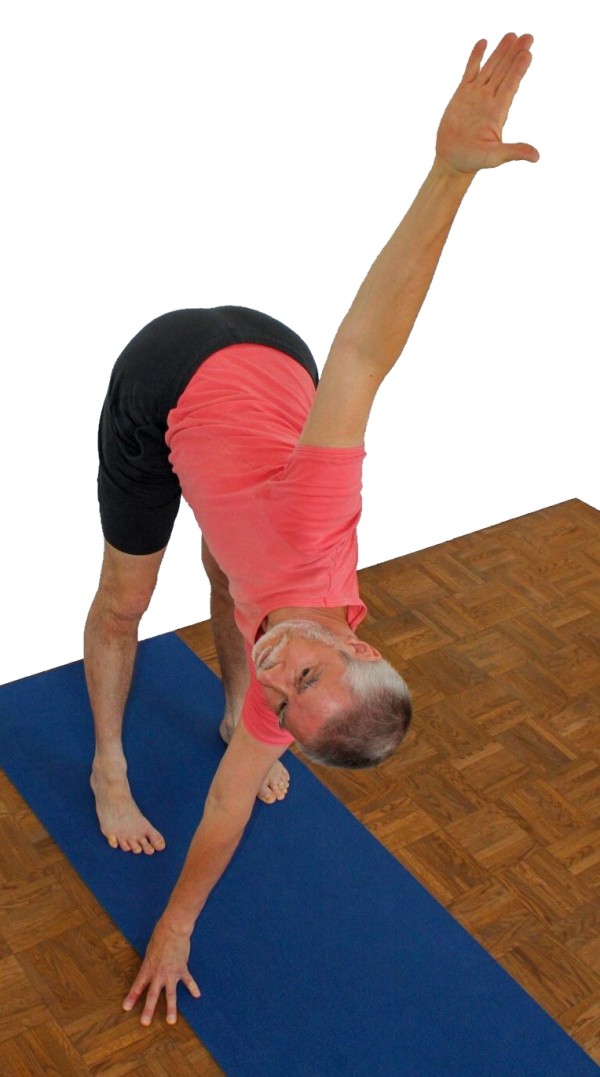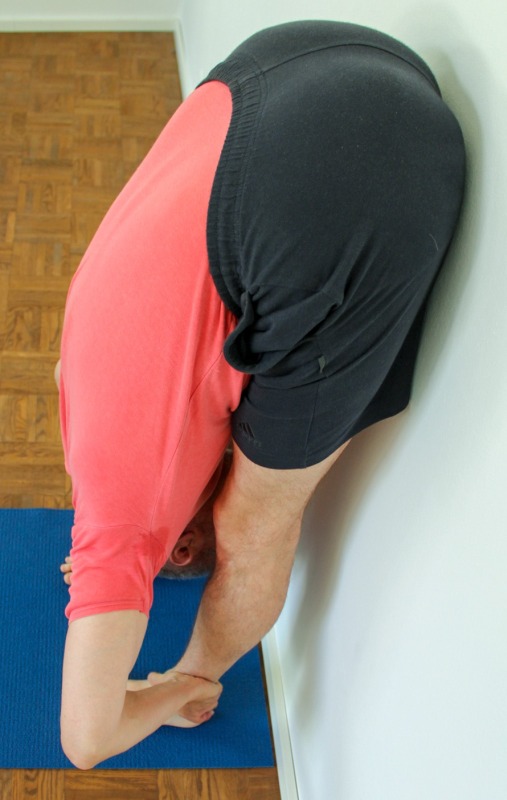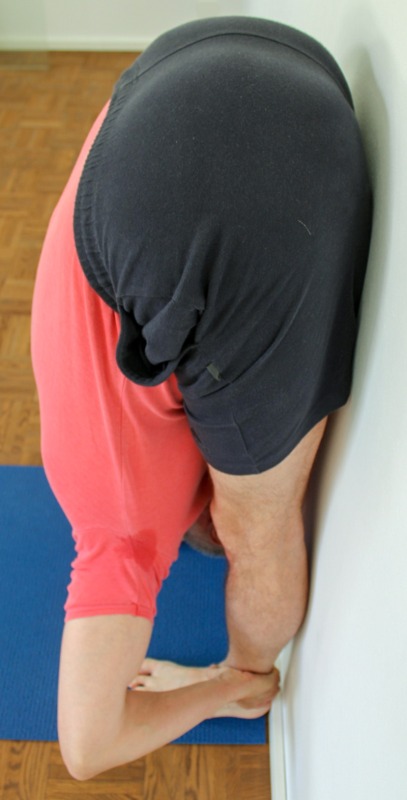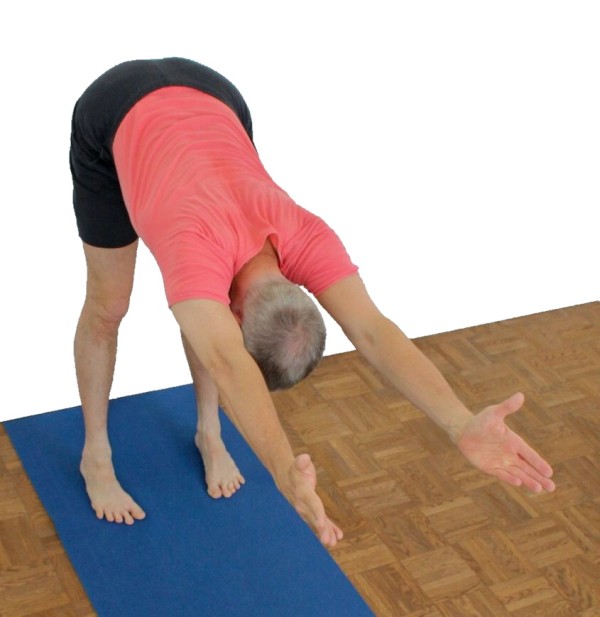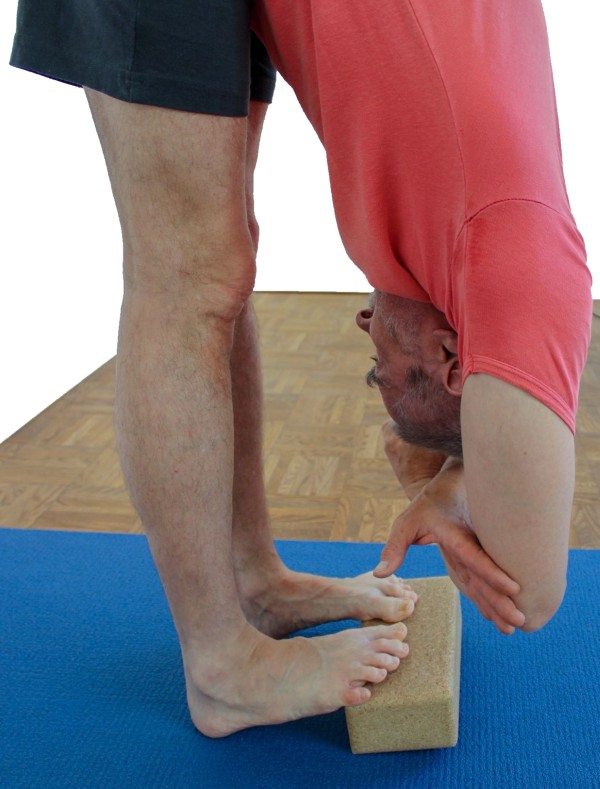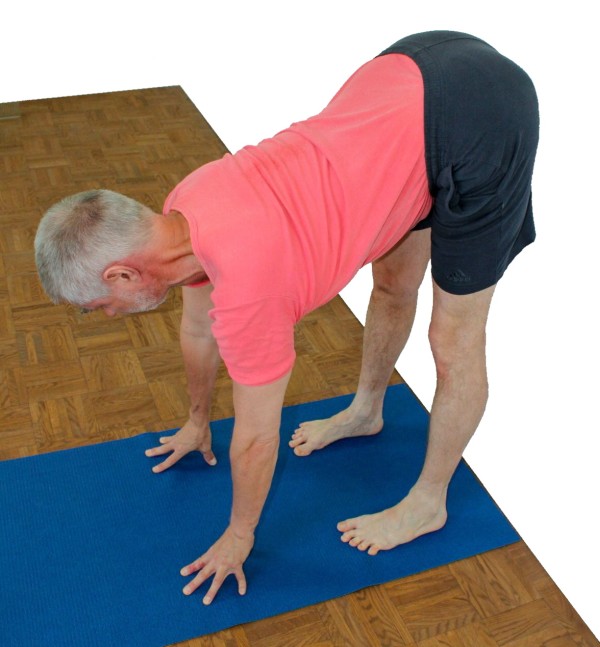- stand in
tadasana, feet hip wide, middle lines of the feet parallel, upper body stretched up
- stretch the knees and with some work of the
Quadrizeps keep the knee caps lifted. Turn in the thighs slightly
- grasp both elbows with the other hand and stretch them up to the ceiling. Elevate the shoulder blades.
Stretch the upper body towards the ceiling as well
- tilt the pelvis forward to the maximum quickly while keeping the position
of the arms and take the upper body down at the same speed as you tilt the pelvis.
- Now once again move your head, shoulders and arms down as far as possible.
The pelvis tilts into flexion as much as possible by the power of the hip flexors, so that the maximum
acceptable stretching sensation occurs in the back of the leg.
- keep the legs slightly endorotated
|
- when tilting the pelvis, the pelvis naturally moves slightly backwards so that the centre of gravity is still in the.
base of support . Then move the pelvis forward again. The extent to which the pelvis moves to the front determines how intensively the calf muscles are brought to work.
For people with weak calf muscles, especially those with inclination to develope a
shinbone edge syndrome it is recommended to practice uttanasana (also) as calf strengthening. Experiment with other foot positions than parallel pointing forward, instead turn e. g. the feet noticeably out
- any relief of the back of the leg by using the back muscles can mean a lesser
or greater load on the lower back. Therefore, always practice the exercise
concerning the legs intensively! Never tilt the pelvis forward half-heartedly!
Never hang almost passively in a pose! These prerequisites are even more valid
for the rigid beginner than for the already very flexible person.
- Make sure not only to hang on the outer edges of the foot, which is usually
associated with the tendency to turn out the legs. The legs should rather
turn in, i. e. the inner knees move more strongly backwards than the outer knee.
The slight endorotation of the legs causes, among other things, that the
ischial bones move a little apart, which eases the flexion in the hips
- as in many bends forward, also here the last 1 to 2 degrees stretching in
the knees are the most interesting.
- Trembling in the knees is a completely normal phenomenon for the stiff
beginner and results from the gross imbalance between the poor ability of the
Quadrizeps, in an almost straight knee (i. e. almost maximum contraction of the
quadriceps)
to perform further
concentric contraction and the stiffness of the antagonists to be stretched.
This often leads to a resonance phenomenon with amplitudes of under
certain circumstances more than 1 cm. From a less physiological point of view,
we observe here the start of the knee system from
tamas to
rajas.
- to tilt the pelvis forward more easily, and to stretch the
ischiocrurale Gruppe more intensively, you can
- grab your buttocks and pull them up. This causes an elevation of the ischial bones,
which directly improves the stretching of some muscles, because they origin there.
- bend the knees, than tilt the pelvis maximum into flexion with the power of the
m.iliopsoas (or additionally with the power of the elbow flexors
by pulling on the lower leg)
In cases of halfway good flexibility the upper part of the body can be pressed onto the thighs.
Restore the stretch of the knees trying to keep the contact between upper body and thighs,
see the corresponding variant.
- do not use the
m. rectus femoris, in order ti tilt the pelvis, but try to leave it soft,
as using it might cause cramping.
- with more frequent intensive practice of forward bends some people have a tendency to strain the
hamstrings at their origin on the ischial bone.
That's usually not a serious injury, but in some forward bends,
such as
uttanasana, causes a painful sensation at the ischal bone a few centimetres down the leg.
This disorder usually dissolves not easily unless you would not do any forward bends for
months on end. But even this would improve the sensation in the affected region,
but would not solve the underlying problem, and with the resumption of forward bends,
the complaints would reappear. A remedy is achieved here by practicing the
ischiocrural group in a different way than usually: stretch the knee from bent knee with the knee held in maximum
Flexion in the hips, instead as commonly first stretch the knee and then bend the hips
It is a good recommendation to practitioners and instructors to every now and
then practise resp. let them practise this second way. This variant can
be excellently combined with various applications of the arm, e. g.
in the form of a pull on the lower legs. Another way to get this problem
under control, is to stretch the affected
ischiocrural group by application of physical pressure transversely to the alignment of the muscle fibres.
This can easily be practised in single-sided forward bends like
janu sirsasana or
tryanga mukhaikapada pascimottanasana with a stick under the middle of the back of the upper leg, transversly orientated,
on which the muscle is pushed then which makes it evade and thus stretches it.
Another very helpful means to get these complaints under control is regenerative
training of the hamstrings. The most effective exercise is deadlifting,
in which the hip joints are bent only so far that no other sensation than stretching and exertion occurs.
The point at which discomfort occurs, according to experience, depends more on the degree of flexion than on the weight.
- Leave the abdominal muscles (especially rectus abdominis) soft. It's not about
moving your head and shoulders towards your lower leg, it's about moving down
towards the ground. The upper part of the body does not do any bending beyond
the effect of gravity (flexion of the spine), just as it would not extend
in any way by force of the back muscles.
| known issues that may occur even when practicing correctly | - pain in the lower back
Despite correct execution, pain in the lower back can occur
(rather rarely). This is usually the case with people who have
started to practice relatively stiffly and do not use the hip flexors
in forward bends to enhance flexion, because they want to avoid
at least a little bit of the stretching sensation in the ischiocrural
group. This means nothing more than that they become accustomed to
practicing forward bends incorrectly and develop more and more
flexibility in the lumbar spine over time instead of stretching the
back of the leg as urgently needed. If the process is already
relatively advanced, one can see that the lumbar spine is quite
impressive flexible in terms of forward bends in some cases.
It can then be useful to protect the lumbar spine by placing your
hands on upright blocks. It is fundamental to gain understanding and
feeling for the powerful tilting of the pelvis into the flexion
from the strength of the hip flexors! The feeling for this is
usually experienced with less flexion in the hips easier than in
maximum forward bend - pain in the back of the knee
see FAQ - pain at the origin of the ischiocrural group at the ischial bone
see FAQ
|
|
